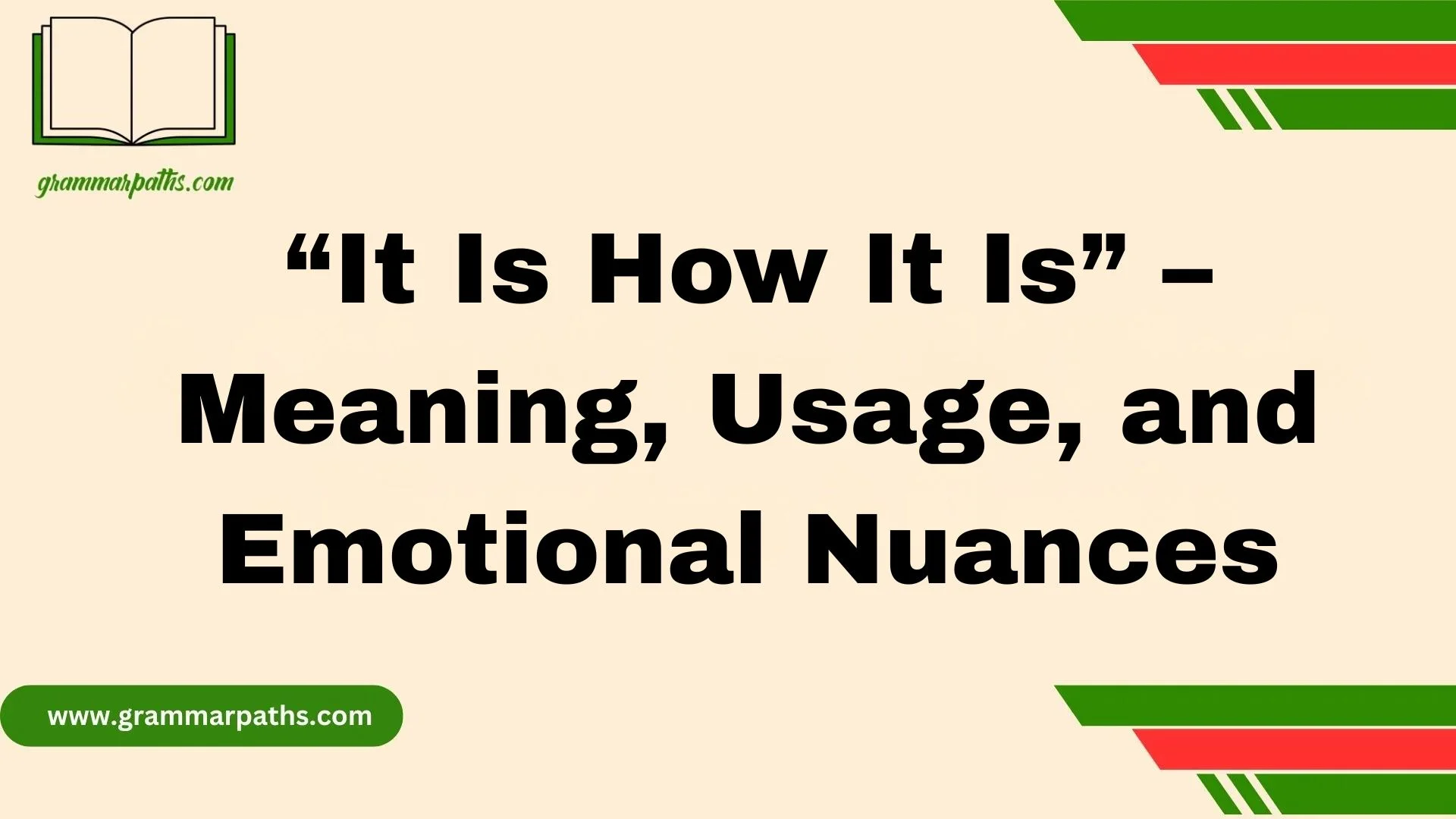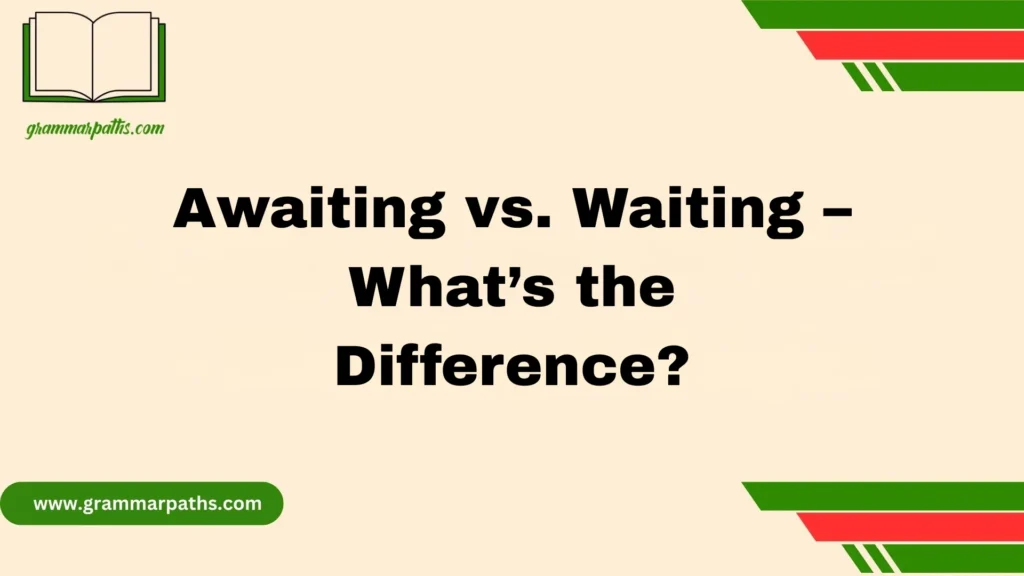Sometimes, in everyday life, you hear the phrase “It is how it is,” and at first, it might feel like a throwaway remark. But anyone who has really listened to people use this small expression knows it carries an unexpected weight. Its simplicity is deceptive; beneath the charm lies a meaning shaped by context, cultures, and tone. This phrase often appears in a tough conversation or when sharing deep emotion, offering a quiet acceptance of things we cannot change. It acts as a marker of resilience, a tool to cope with challenges, and a spoken philosophy that acknowledges problems without necessarily fixing them.
From my experience, hearing “It is how it is” often brings a sense of peace, helping us handle difficult feelings and maintain control over how we process life. The layers of complexity in this expression show that its usage is not just about words—it reflects the core of emotional interpretation, comparisons with other phrases, and subtle meanings that make it a powerful, almost universal way to navigate the world. Paying attention to its grammar, language, and tone can reveal how people internalize acceptance and acknowledgment, making it a deeply human tool for everyday reflection.
Origins and History
The phrase “It is how it is” doesn’t have a precisely documented origin, but it emerges from the natural evolution of conversational English. English speakers have long created expressions that convey acceptance or inevitability, and this phrase captures that sentiment perfectly.
Historically, English has seen similar expressions like:
- “Such is life” – a 19th-century idiom expressing acceptance.
- “That’s the way the cookie crumbles” – popularized in the 20th century, casual and idiomatic.
Over time, “It is how it is” became a staple in informal American English, often replacing longer explanations when acknowledging situations beyond one’s control. Unlike “It is what it is”, which emphasizes reality, “It is how it is” subtly hints at the way things unfold or exist naturally.
Literal vs. Figurative Meaning
At its core, the phrase is simple:
- Literal interpretation: Things exist in a certain way. That’s the fact.
- Figurative interpretation: You accept circumstances without trying to change them.
Consider these examples:
- Literal: “The window is broken. It is how it is.” → Observing fact.
- Figurative: “We didn’t get the contract. It is how it is.” → Accepting disappointment gracefully.
This idiom often communicates emotional acceptance, which can range from calm acknowledgment to quiet resignation, depending on the speaker’s tone.
Grammar and Structure Analysis
Breaking down “It is how it is” shows why it works seamlessly in English:
| Component | Explanation |
| It | Pronoun referring to a situation, object, or fact |
| is | Linking verb connecting the subject to its state |
| how it is | Dependent clause describing the manner or condition of the subject |
The phrase is grammatically correct, simple, and conversational. Unlike more formal constructions, it avoids overcomplication while remaining expressive. Some common errors include omitting “how” or confusing it with “It is what it is”, which slightly changes the nuance.
Contexts and Usage
Understanding where and how to use “It is how it is” is key. The phrase works best in informal settings, casual conversations, or situations where acceptance or neutrality is needed.
Common contexts include:
- Workplace setbacks: “The client rejected our proposal. It is how it is.”
- Daily inconveniences: “The bus is late again. It is how it is.”
- Social situations: “He didn’t come to the party. It is how it is.”
Pro Tip: Avoid using it in highly formal writing. Instead, phrases like “That is the situation” or “This is the current status” work better.
Emotional Implications
The phrase carries emotional weight, often more than it seems. It can reflect:
- Acceptance: Calm acknowledgment of reality.
- Resignation: Giving up on changing circumstances.
- Empathy or comfort: Offering reassurance indirectly.
Tone and context are crucial. For example:
- Supportive tone: “You missed the deadline. It is how it is. We’ll adjust.” → Comforting.
- Flat tone: “We lost the game. It is how it is.” → Resignation.
- Ironic tone: “They canceled again. It is how it is.” → Slight frustration or sarcasm.
Understanding the emotional undertone helps interpret whether the speaker is resigned, neutral, or empathetic.
Tone, Delivery, and Nuances
Tone changes everything with this idiom. Stressing certain words alters meaning dramatically:
- “It is how it IS” → Emphasizes inevitability.
- “It IS how it is” → Neutral acknowledgment.
- “It is HOW it is” → Focuses on the manner in which things are.
Pausing naturally between words can add emphasis or soften the impact. Spoken delivery often conveys more than the words themselves.
Real-world Examples
Here are practical illustrations:
Example 1 – Workplace:
“The meeting got postponed again.”
“It is how it is. Let’s focus on preparing for the next one.”
Example 2 – Personal life:
“I can’t change his mind.”
“It is how it is. You’ve done your part.”
Example 3 – Social media:
“Flight delayed for the third time this week. #ItIsHowItIs”
Annotated Example Table:
| Example | Tone | Interpretation |
| “It is how it is. Don’t stress.” | Calm, supportive | Acceptance, reassurance |
| “It is how it is. Nothing we can do.” | Resigned | Acknowledgment of reality |
| “It is how it is… sigh” | Slightly frustrated | Mild resignation or annoyance |
Comparative Analysis: “It Is How It Is” vs. “It Is What It Is”
Both phrases are similar but subtly different:
| Phrase | Emphasis | Typical Usage |
| It is how it is | Focus on manner or condition | Casual, descriptive, sometimes empathetic |
| It is what it is | Focus on reality or fact | Neutral, resigned, or slightly cynical |
Example:
- “The software crashed again. It is how it is.” → Describes circumstance.
- “The software crashed again. It is what it is.” → Accepts fact, no commentary on manner.
Choosing between them depends on whether you’re commenting on how things unfold or just stating a fact.
Common Mistakes and Misuses
Misusing this phrase can make you seem indifferent or sarcastic unintentionally. Common pitfalls:
- Overuse: Saying it too often may convey apathy.
- Wrong tone: Flat tone in sensitive situations can seem unsympathetic.
- Mixing with formal writing: “It is how it is” rarely fits academic papers or reports.
Tip: Pair the phrase with explanatory statements if needed:“It is how it is, but we can explore other solutions.”
Encouragement and Comfort
Interestingly, this idiom can offer reassurance. It conveys:
- “I understand; we cannot control everything.”
- “You’re not alone; situations are sometimes beyond our control.”
It’s especially effective in emotional contexts:
- Supporting friends: “You didn’t get the promotion. It is how it is. Your efforts still matter.”
- Consoling colleagues: “The client rejected the pitch. It is how it is. We’ll improve for next time.”
The subtlety lies in delivery—a warm, calm tone communicates support better than a neutral or flat tone.
Conclusion
The phrase “It is how it is” may seem simple, but its depth is remarkable. Through its use in everyday speech, it conveys quiet acceptance, resilience, and a sense of peace even in tough conversations or moments of deep emotion. By understanding its meaning, context, tone, and subtle meanings, we see it as more than just words—it becomes a tool to cope with things we cannot change, handle problems, and reflect on life with a universal, powerful approach. Recognizing its layers, grammar, and cultural nuances helps us appreciate this spoken philosophy as a practical marker for emotional intelligence and daily interactions.
FAQs
Q1: What does “It is how it is” really mean?
It is a phrase expressing acceptance of things we cannot change, showing resilience, acknowledgment, and sometimes deep emotion without needing to fix anything.
Q2: How should I use it in everyday speech?
You can use it as a small expression in tough conversations, when handling challenges, or when sharing feelings, to communicate a sense of peace and universal understanding.
Q3: Is it considered informal or formal?
It’s generally informal, though the meaning, context, tone, and emotional interpretation determine how it fits into spoken philosophy or casual language.
Q4: Can it help with emotional coping?
Yes. Its layers of complexity provide a powerful tool for processing problems, managing feelings, and maintaining control in daily life.
Q5: Does culture affect its interpretation?
Absolutely. Different cultures may give it unique subtle meanings, but the core message of acceptance and resilience remains universal.

Emma Brooke is a passionate language expert and contributor at GrammarPaths.com, where she helps learners navigate the complexities of English grammar, idioms, and effective writing. With a strong academic background and years of teaching experience, Emma excels at turning tricky grammar rules into simple, practical lessons that readers can easily grasp.










